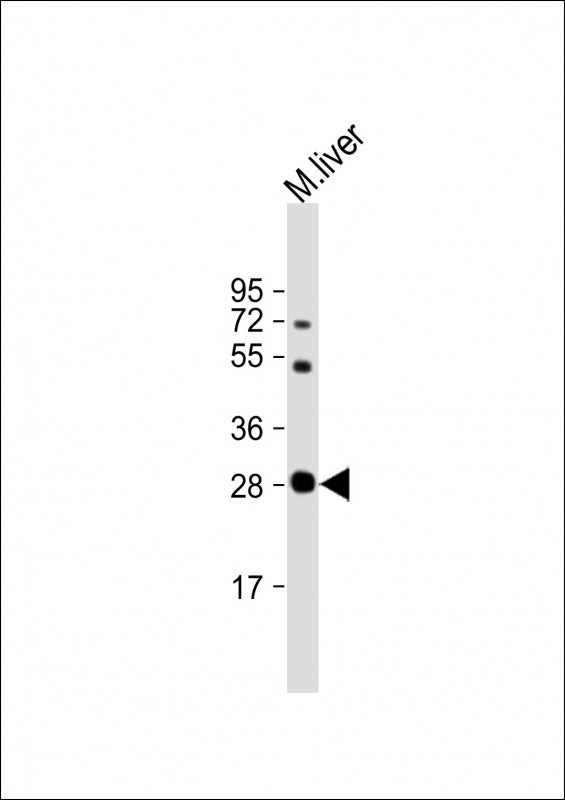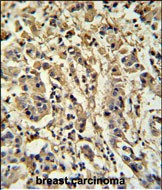M Sirt3 Antibody (C-term)
Affinity Purified Rabbit Polyclonal Antibody (Pab)
- 产品详情
- 文献引用 : 2
- 实验流程
- 背景知识
Application
| WB, IHC-P, E |
|---|---|
| Primary Accession | Q8R104 |
| Other Accession | NP_071878.2 |
| Reactivity | Human, Mouse |
| Host | Rabbit |
| Clonality | Polyclonal |
| Isotype | Rabbit IgG |
| Calculated MW | 36615 Da |
| Antigen Region | 304-334 aa |
| Gene ID | 64384 |
|---|---|
| Other Names | NAD-dependent protein deacetylase sirtuin-3, 351-, Regulatory protein SIR2 homolog 3, SIR2-like protein 3, mSIR2L3, Sirt3, Sir2l3 |
| Target/Specificity | This Sirt3 antibody is generated from rabbits immunized with a KLH conjugated synthetic peptide between 304-334 amino acids from the C-terminal region of Mouse Sirt3. |
| Dilution | WB~~1:64000 IHC-P~~1:100~500 E~~Use at an assay dependent concentration. |
| Format | Purified polyclonal antibody supplied in PBS with 0.09% (W/V) sodium azide. This antibody is purified through a protein A column, followed by peptide affinity purification. |
| Storage | Maintain refrigerated at 2-8°C for up to 2 weeks. For long term storage store at -20°C in small aliquots to prevent freeze-thaw cycles. |
| Precautions | M Sirt3 Antibody (C-term) is for research use only and not for use in diagnostic or therapeutic procedures. |
| Name | Sirt3 {ECO:0000303|PubMed:19333382, ECO:0000312|MGI:MGI:1927665} |
|---|---|
| Function | NAD-dependent protein deacetylase (PubMed:17923681, PubMed:18794531, PubMed:21172655, PubMed:23835326, PubMed:26620563). Activates or deactivates mitochondrial target proteins by deacetylating key lysine residues (PubMed:17923681, PubMed:18794531, PubMed:21172655, PubMed:23835326). Known targets include ACSS1, IDH, GDH, PDHA1, SOD2, LCAD, SDHA, MRPL12 and the ATP synthase subunit ATP5PO (PubMed:16790548, PubMed:18794531, PubMed:21172655). Contributes to the regulation of the cellular energy metabolism (PubMed:23835326, PubMed:36804859). Important for regulating tissue-specific ATP levels (PubMed:18794531, PubMed:24252090). In response to metabolic stress, deacetylates transcription factor FOXO3 and recruits FOXO3 and mitochondrial RNA polymerase POLRMT to mtDNA to promote mtDNA transcription (PubMed:23283301). Acts as a regulator of ceramide metabolism by mediating deacetylation of ceramide synthases CERS1, CERS2 and CERS6, thereby increasing their activity and promoting mitochondrial ceramide accumulation (PubMed:26620563). Regulates hepatic lipogenesis (PubMed:36804859). Uses NAD(+) substrate imported by SLC25A47, triggering downstream activation of PRKAA1/AMPK-alpha signaling cascade that ultimately downregulates sterol regulatory element-binding protein (SREBP) transcriptional activities and ATP- consuming lipogenesis to restore cellular energy balance (PubMed:36804859). In addition to protein deacetylase activity, also acts as a protein-lysine deacylase by mediating delactylation of proteins, such as CCNE2 and 'Lys-16' of histone H4 (H4K16la) (By similarity). |
| Cellular Location | [Isoform L]: Mitochondrion matrix |
| Tissue Location | Expressed in cardiomyocytes (at protein level) (PubMed:11056054, PubMed:35959657). Expressed in the brain, liver, kidney and testes (PubMed:11056054). Expressed in skeletal muscles (at protein level) (PubMed:23283301, PubMed:23835326) |
For Research Use Only. Not For Use In Diagnostic Procedures.

Provided below are standard protocols that you may find useful for product applications.
BACKGROUND
SIRT3 is a member of the sirtuin family of proteins, homologs to the yeast Sir2 protein. Members of the sirtuin family are characterized by a sirtuin core domain and grouped into four classes. The functions of human sirtuins have not yet been determined; however, yeast sirtuin proteins are known to regulate epigenetic gene silencing and suppress recombination of rDNA. Studies suggest that the human sirtuins may function as intracellular regulatory proteins with mono-ADP-ribosyltransferase activity. The SIRT3 is included in class I of the sirtuin family.
REFERENCES
Hirschey, M.D., et al. Nature 464(7285):121-125(2010)
Pillai, V.B., et al. J. Biol. Chem. 285(5):3133-3144(2010)
Kim, H.S., et al. Cancer Cell 17(1):41-52(2010)
终于等到您。ABCEPTA(百远生物)抗体产品。
点击下方“我要评价 ”按钮提交您的反馈信息,您的反馈和评价是我们最宝贵的财富之一,
我们将在1-3个工作日内处理您的反馈信息。
如有疑问,联系:0512-88856768 tech-china@abcepta.com.






















 癌症的基本特征包括细胞增殖、血管生成、迁移、凋亡逃避机制和细胞永生等。找到癌症发生过程中这些通路的关键标记物和对应的抗体用于检测至关重要。
癌症的基本特征包括细胞增殖、血管生成、迁移、凋亡逃避机制和细胞永生等。找到癌症发生过程中这些通路的关键标记物和对应的抗体用于检测至关重要。 为您推荐一个泛素化位点预测神器——泛素化分析工具,可以为您的蛋白的泛素化位点作出预测和评分。
为您推荐一个泛素化位点预测神器——泛素化分析工具,可以为您的蛋白的泛素化位点作出预测和评分。 细胞自噬受体图形绘图工具为你的蛋白的细胞受体结合位点作出预测和评分,识别结合到自噬通路中的蛋白是非常重要的,便于让我们理解自噬在正常生理、病理过程中的作用,如发育、细胞分化、神经退化性疾病、压力条件下、感染和癌症。
细胞自噬受体图形绘图工具为你的蛋白的细胞受体结合位点作出预测和评分,识别结合到自噬通路中的蛋白是非常重要的,便于让我们理解自噬在正常生理、病理过程中的作用,如发育、细胞分化、神经退化性疾病、压力条件下、感染和癌症。







